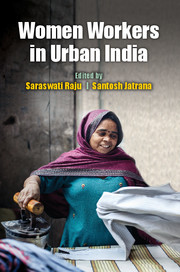Book contents
- Frontmatter
- Contents
- List of Figures
- List of Tables
- Preface
- 1 Setting the Backdrop
- 2 Women Workers in Urban India and the Cities
- 3 Gendered Vulnerabilities: Work-Life Trajectories of Female Domestic Workers in Jaipur
- 4 Occupational Domestication in a Post-Resettlement Context: An Analysis of Women's Work in Kannagi Nagar, Chennai
- 5 Old Jobs in New Forms: Women's Experiences in the Housekeeping Sector in Pune
- 6 Persistent Inequalities and Deepened Burden of Work? An Analysis of Women's Employment in Delhi
- 7 Spare Change for Spare Time? Homeworking Women in Banaras
- 8 Gender, Work and Space: Home-based Workers in Garment Industry in Kolkata
- 9 Labour Control and Responses: Women Workers in an Apparel Park in Kerala
- 10 New Urban Economic Spaces and the Gendered World of Work in Kolkata
- 11 Gender Equality and Women's Employment in the Banking Sector in India
- 12 Women Body Screeners and the Securitization of Space in Indian Cities
- Notes on Contributors
- Index
2 - Women Workers in Urban India and the Cities
Published online by Cambridge University Press: 05 May 2016
- Frontmatter
- Contents
- List of Figures
- List of Tables
- Preface
- 1 Setting the Backdrop
- 2 Women Workers in Urban India and the Cities
- 3 Gendered Vulnerabilities: Work-Life Trajectories of Female Domestic Workers in Jaipur
- 4 Occupational Domestication in a Post-Resettlement Context: An Analysis of Women's Work in Kannagi Nagar, Chennai
- 5 Old Jobs in New Forms: Women's Experiences in the Housekeeping Sector in Pune
- 6 Persistent Inequalities and Deepened Burden of Work? An Analysis of Women's Employment in Delhi
- 7 Spare Change for Spare Time? Homeworking Women in Banaras
- 8 Gender, Work and Space: Home-based Workers in Garment Industry in Kolkata
- 9 Labour Control and Responses: Women Workers in an Apparel Park in Kerala
- 10 New Urban Economic Spaces and the Gendered World of Work in Kolkata
- 11 Gender Equality and Women's Employment in the Banking Sector in India
- 12 Women Body Screeners and the Securitization of Space in Indian Cities
- Notes on Contributors
- Index
Summary
Introduction
Early 1990s is somewhat of a watershed in terms of Indian economy, which had seen rather unprecedented trade liberalization in India in response to internal and external impulses. Following the rise in fiscal deficit, negative industrial growth, enhanced inflation and political uncertainties, structural reforms were introduced in industrial and import licensing sector for microeconomic stabilization. One of the impacts was the changing employment and wage pattern in the labour market. Outward looking policies aimed at greater participation in international economy and increased export were supposed to favour labour surplus countries. Such globalizing processes, accompanied by macroeconomic changes also led to an integration of the different labour markets on the one hand and rising segregation and segmentation within, on the other. Whereas labour has become relatively more mobile and tied with contact-based migration, the segmentation of labour markets has been due to rising concentration in certain sectors and types of economic activities (Paul and Raju 2014). Overall, such processes have brought the informality in the labour markets to the limelight. While some call this informality and globalization linkage as a new phase in capitalism, others contend it to be unique in itself. The emergence of the ‘new economy’ is characterized by an enhanced engagement of women labour as a cheap source of maintaining the ‘standards of capitalism’ and ‘reserve army of labour’ by making them act as a support system of the economy. This is widespread in almost all developing countries and more so in India where the rise of women's employment is usually accompanied by rise in distress in the Indian economy. However, women display a high presence in the informal employment as casual labourers and self-employed and also in domestic labour as regular salaried.
Export-oriented growth, which is becoming extremely competitive despite remaining committed in principle to collective interests at some social cost, not only reconfigure the existing social and gendered constructs to serve the interests of few and marginalize many, women are usually less likely to be highly mobile and their access to resources and human capital remains limited (Raju 2013). As Arora (2012) points out, India has a continuously rising import/ GDP ratio since 1990–1991 and yet the trade openness may be illusory when women workers are brought in.
- Type
- Chapter
- Information
- Women Workers in Urban India , pp. 36 - 66Publisher: Cambridge University PressPrint publication year: 2016



